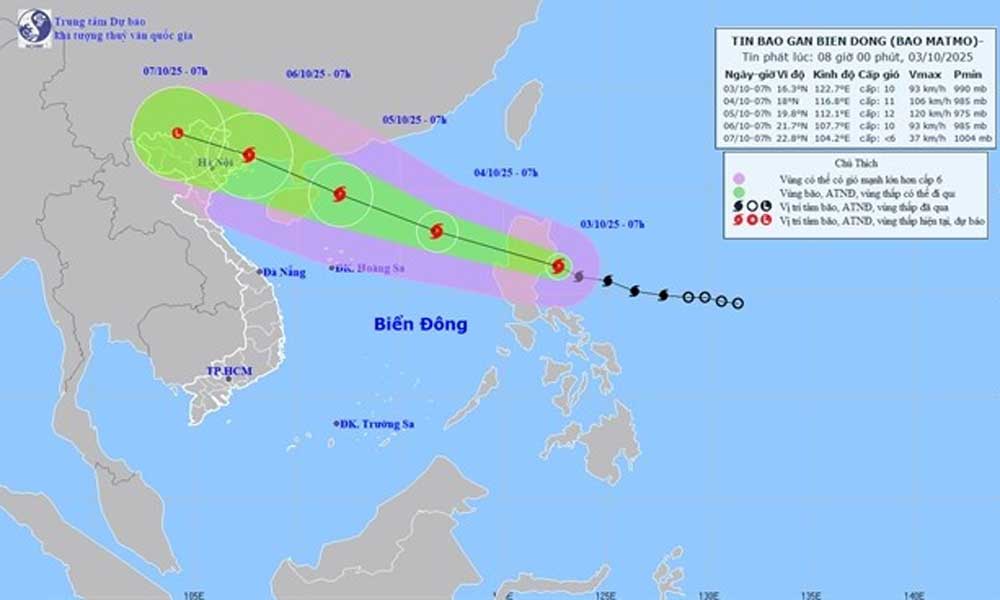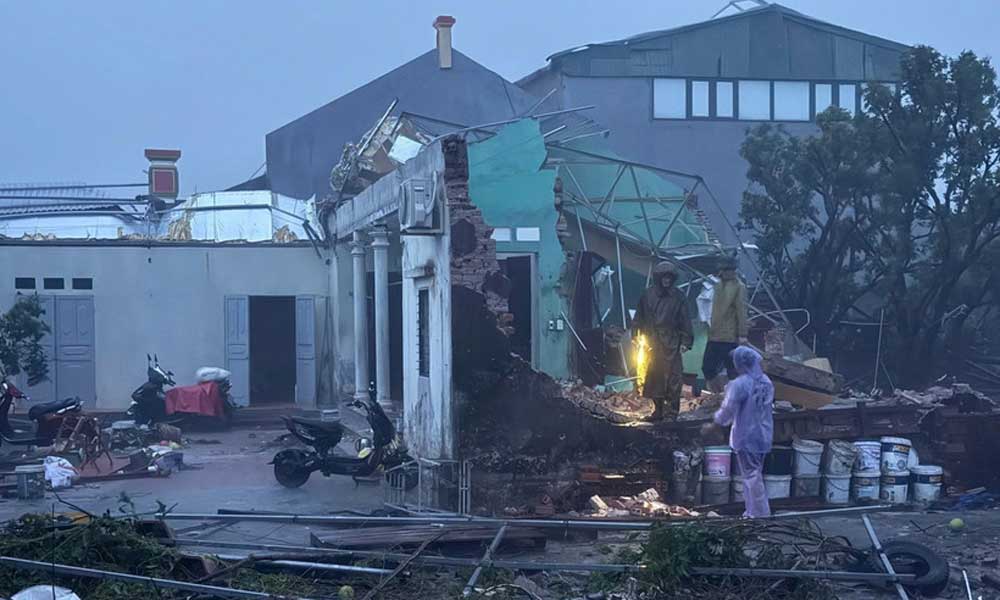Northern localities brace for Typhoon Matmo
According to the National Centre for Hydro-Meteorological Forecasting, as of 2 pm on October 4, the storm’s eye was located at 18.4 degrees North latitude and 115.1 degrees East longitude, about 330 km east-northeast of Hoang Sa special zone. Winds near the centre reached level 12 (118–133 km/h), with gusts up to level 15.
Provinces in the northern region are ramping up emergency measures as Typhoon Matmo, the 11th storm to hit the East Sea this year, continues to strengthen on its way towards the mainland.
 |
|
The forecast path of Typhoon Matmo in the next few days. |
Typhoon Matmo, has moved closer to Vietnam’s northern coast, prompting the Government to issue urgent directives to ensure safety for people and property.
According to the National Centre for Hydro-Meteorological Forecasting, as of 2 pm on October 4, the storm’s eye was located at 18.4 degrees North latitude and 115.1 degrees East longitude, about 330 km east-northeast of Hoang Sa special zone.
Winds near the centre reached level 12 (118–133 km/h), with gusts up to level 15. The storm was moving west-northwest at around 25 km/h and was expected to gain further strength.
By 1 pm on October 5, the typhoon is forecast to reach the eastern waters of China’s Leizhou Peninsula with sustained winds of level 12–13 and gusts up to level 16, before weakening gradually as it approaches northern Vietnam.
It is projected to affect Quang Ninh, Hai Phong and nearby provinces between late October 5 and October 6, bringing heavy rains, strong winds, and dangerous sea conditions.
Forecasters warned that the northern East Sea would experience waves 6–8 metres high and extremely rough seas. From October 5, winds in the northern Gulf of Tonkin are expected to strengthen to level 8–9, with areas near the storm’s eye reaching level 10–11 and gusting to 14.
Coastal areas from Quang Ninh to Hai Phong may face water surges of 0.4–0.6 metres, raising the risk of flooding in low-lying zones.
On land, coastal provinces from Quang Ninh to Hung Yen will experience winds of level 6–9, with gusts up to level 11. Inland areas of the northeast may also record strong winds capable of causing tree damage, roof losses and property destruction.
From October 5–7, mountainous and midland provinces in the north are forecast to see heavy rainfall of 150–250 mm, with some locations exceeding 400 mm, raising the risk of flash floods and landslides.
The Red River Delta, Thanh Hoa and Nghe An are expected to receive 70–150 mm of rain, locally higher. Hanoi is likely to see moderate to heavy rainfall of 70–120 mm during October 6–7.
In response, Deputy Prime Minister Tran Hong Ha signed an urgent dispatch on behalf of the Prime Minister on October 4, directing ministries, agencies and localities to prepare for Typhoon Matmo.
The document emphasised the storm’s severity, especially as it comes immediately after two earlier storms, creating a “compound disaster” scenario of storm-on-storm and floods-on-floods.
The PM urged authorities to recognise the high risks of flash floods, landslides, and severe flooding in northern and north-central provinces, and to implement decisive and timely measures to safeguard lives and minimise losses.
Coastal provinces from Quang Ninh to Ninh Binh were instructed to ensure the safety of vessels, aquaculture farms, and coastal tourism activities, while preparing for possible evacuations.
Local leaders in mountainous provinces such as Lao Cai were ordered to promptly relocate households in areas at risk of landslides, with evacuation already underway in Bao Ha commune.
The Government also tasked the Ministry of Agriculture and Environment with monitoring rainfall and river flows, including transboundary water sources, and updating forecasts based on international data to provide the most accurate warnings possible.
The Ministry of Foreign Affairs was directed to coordinate with China to share flood discharge information from upstream reservoirs to avoid unexpected incidents downstream.
Authorities stressed the importance of applying the “four on-the-spot” approach with on-the-spot command, manpower, means, and logistics while pre-positioning forces and materials in vulnerable locations.
The PM also requested localities to update and refine disaster response scenarios for different levels of risk, ensuring readiness for multiple types of disasters occurring simultaneously.
 Bắc Ninh
Bắc Ninh







.jpg)


Reader's comments (0)